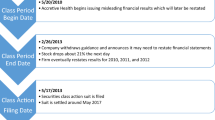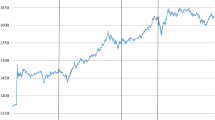Abstract
In a study of 1,131 stock splits spanning the period 1983–1989 we observe an increase in the number of trades as well as a reduction in the mean trade size following the split. Combined with earlier reported findings of an increase in the number of shareholders postsplit, we conclude that the number of liquidity traders increases after a split. We confirm the previously observed increase in the bid-ask spread following a split, and upon decomposition of the spread find an increase in its adverse selection component in the postsplit period. This is consistent with the finding by Brennan and Hughes (1991) of an increase in the number of analysts following a stock after a split. Further, observing a decrease in market depth following a split we determine that Kyle-type models incorporating diverse private information for informed traders most correctly describe the nature of security trading. Since this decrease in postsplit market depth is not related to the trading volume or the split factor, we reject price correction explanations for stock splits.
Similar content being viewed by others
References
Admati, A.R. and P. Pfleiderer, “A Theory of Intraday Patterns: Volume and Price Variability.”Review of Financial Studies 1, 3–40, (1988).
Amihud, Y. and H. Mendelson, “Dealership Markets: Market-Making With Inventory.”Journal of Financial Economics 8, 31–53, (1980).
Block, W.A. and A.W. Kleidon, “Periodic Market Closure and Trading Volume: A Model of Intraday Bids and Asks.”Journal of Economic Dynamics and Control 16, 451–489, (1992).
Brennan, M.J. and T.E. Copeland, “Stock Splits, Stock Prices and Transactions Costs.”Journal of Financial Economics, 22, 83–101, (1988).
Brennan, M.J. and P.J. Hughes, “Stock Prices and the Supply of Information.”Journal of Finance 46, 1665–1592, (1991).
Choi, D. and R.W. Masulis, “Measuring the Impacts of Dividend Capture Trading: A Market Microstructure Analysis.” Working paper, Southern Methodist University, (1991).
Conroy, Robert M., Robert S. Harris, and Bruce A. Benet, “The Effects of Stock Splits on Bid-Ask Spreads.”Journal of Finance XIV, 1285–1295, (September 1990).
Cooper, S.K., J.C. Groth, and W.E. Avera, “Liquidity, Exchange Listing, and Common Stock Performance.”Journal of Economics and Business 37, 19–34, (February 1985).
Copeland, T.E., “Liquidity Changes Following Stock Splits.”Journal of Finance 34, 115–141, (1979).
Fama, E.F., L. Fisher, M.C. Jensen, and R. Roll, “The Adjustment of Stock Prices to New Information.”International Economic Review, 10, 1–21, (1969).
George, T.J., G. Kaul, and M. Nimalendran, “Estimation of the Bid-Ask Spread and Its Components: A New Approach.”Review of Financial Studies 4, 623–656, (1991).
Glosten, L.R. and P. Milgrom, “Bid, Ask and Transaction Prices in a Specialist Market with Heterogeneously Informed Traders.”Journal of Financial Economics, 14, 71–100, (1985).
Grinblatt, M.S., R.W. Masulis, and S. Titman, “The Valuation of Stock Splits and Stock Dividends.”Journal of Financial Economics 13, 461–490, (1984).
Kyle, A.S., “Continuous Auctions and Insider Trading.”Econometrica 53, 1315–1335, (1985).
Lakonishok, J. and B. Lev, “Stock Splits and Stock Dividends: Why, Who and When.”Journal of Finance 42, 913–932, (1987).
Lamoureux, C.G. and P. Poon, “The Market Reaction to Stock Splits.”Journal of Finance 42, 1347–1370, (1987).
McInish, T.H. and R.A. Wood, “An Analysis of Intraday Patterns in Bid/Ask Spreads for NYSE Stocks.”Journal of Finance 47, 753–764, (June 1992).
McNichols, M. and A. Dravid, “Stock Dividends, Stock Splits and Signaling.”Journal of Finance XIV, 857–879, (July 1990).
Murray, D., “Further Evidence on the Liquidity Effects of Stock Splits and Stock Dividends,”Journal of Financial Research 8, 59–67, (1985).
Stoll, H.R., “Inferring the Components of the Bid-Ask Spread: Theory and Empirical Tests.”Journal of Finance 39, 1127–1139, (1989).
Subrahmanyam, A., “A Theory of Trading in Stock Index Futures.”Review of Financial Studies, 4, 17–51, (1991).
Author information
Authors and Affiliations
Rights and permissions
About this article
Cite this article
Ferris, S.P., Hwang, CY. & Sarin, A. A microstructure examination of trading activity following stock splits. Rev Quant Finan Acc 5, 27–41 (1995). https://doi.org/10.1007/BF01074850
Issue Date:
DOI: https://doi.org/10.1007/BF01074850




